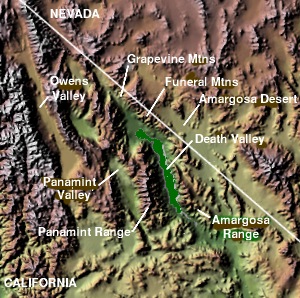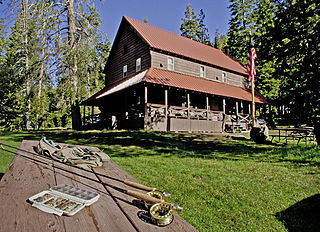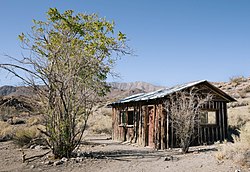
Charles Milles Manson was an American criminal, cult leader and musician who led the Manson Family, a cult based in California, in the late 1960s. Some of the members committed a series of at least nine murders at four locations in July and August 1969. In 1971, Manson was convicted of first-degree murder and conspiracy to commit murder for the deaths of seven people, including the film actress Sharon Tate. The prosecution contended that, while Manson never directly ordered the murders, his ideology constituted an overt act of conspiracy.

Philmont Scout Ranch is a ranch located in Colfax County, New Mexico, near the village of Cimarron; it covers 140,177 acres (56,728 ha) of wilderness in the Sangre de Cristo Mountains on the east side of the Cimarron Range of the Rocky Mountains. Donated by oil baron Waite Phillips, the ranch is owned and operated by the Boy Scouts of America. It is a National High Adventure Base where crews of Scouts and Venturers take part in backpacking treks and other outdoor activities. By land area, it is one of the largest youth camps in the world. During the 2019 season, between June 8 and August 22, an estimated 24,000 Scouts and adult leaders backpacked through the Ranch's extensive backcountry. That same year 1,302 staff were responsible for the Ranch's summer operations.

Patricia Dianne Krenwinkel is an American convicted murderer and former member of the Manson Family. During her time with Manson's group, she was known by various aliases such as Big Patty, Yellow, Marnie Reeves and Mary Ann Scott, but to The Family, she was most commonly known as Katie.

Lynette Alice "Squeaky" Fromme is an American criminal who was a member of the Manson family, a cult led by Charles Manson. Though not involved in the Tate–LaBianca murders for which the Manson family is best known, she attempted to assassinate President Gerald Ford in 1975. For that crime, she was sentenced to life in prison. She was paroled from prison on August 14, 2009, after serving approximately 34 years. She published a book about her life in 2018.

The Manson Family was a commune, gang, and cult led by criminal Charles Manson that was active in California in the late 1960s and early 1970s. The group consisted of approximately 100 followers, who lived an unconventional lifestyle, frequently using psychoactive drugs, including Benzedrine (amphetamine) and hallucinogens such as LSD. Most were young women from middle-class backgrounds, many of whom were attracted by hippie culture and communal living and then radicalized by Manson's teachings.

Helter Skelter is a 1976 television film based on the 1974 book by prosecutor Vincent Bugliosi and Curt Gentry. In the United States, it aired over two nights. In some countries it was shown in cinemas, with additional footage including nudity, foul language, and more violence.

Scotty's Castle is a two-story Mission Revival and Spanish Colonial Revival style villa located in the Grapevine Mountains of northern Death Valley in Death Valley National Park, California, US. Scotty's Castle is named for gold prospector Walter E. Scott, although Scott never owned it, nor is it an actual castle.

Spahn Ranch, also known as the Spahn Movie Ranch, was a 55-acre movie ranch in Los Angeles, California. For a period it was used as a ranch, dairy farm and later movie set during the era of westerns. After a decline in use for filming by the 1950s, its owner George Spahn established a stable for renting horses for riding on the varied acres. It became known in the late 20th century as the primary headquarters of Charles Manson and his cult followers, the "Manson Family", for much of 1967 and 1968. They were notorious for the Tate-LaBianca murders of August 1969.

The Panamint Valley is a long basin located east of the Argus and Slate ranges, and west of the Panamint Range in the northeastern reach of the Mojave Desert, in eastern California, United States.
A movie ranch is a ranch that is at least partially dedicated for use as a set in the creation and production of motion pictures and television shows. These were developed in the United States in southern California, because of the climate.

Jack London State Historic Park, also known as Jack London Home and Ranch, is a California State Historic Park near Glen Ellen, California, United States, situated on the eastern slope of Sonoma Mountain. It includes the ruins of a house burned a few months before Jack London and family were to move in, a cottage in which they had lived, another house built later, and the graves of Jack London and his wife. The property is both a California Historical Landmark and a National Historic Landmark.
Hannah Connell Barker (1844–1918) was an early resident of Boulder, Colorado. Barker was a teacher, civic leader, businesswoman and land developer in an era when industrious women were not commonly recognized for their contributions. Among other things, Barker served as a teacher; as director of the Boulder Bank; and was instrumental in platting and developing significant parts of the City of Boulder. She also owned the land that was used for the construction of Barker Meadow Reservoir, Boulder's primary source of water.

Mary Theresa Brunner is an American criminal and former member of the "Manson Family" who was present during the 1969 murder of Gary Hinman, a California musician and Ph.D. candidate. She was arrested for numerous offenses, including credit card theft and armed robbery, and she served a prison sentence at the California Institution for Women.
Paul Alan Watkins was an American man who was a member of Charles Manson's "Family". In the period leading up to Manson's trial for the Tate–LaBianca murders, Watkins provided the prosecution with information that clarified the "Helter Skelter" motive. He is not to be confused with Tex Watson.

Drakesbad Guest Ranch, also known simply as Drakesbad, is a resort near Chester, California. It is located on Hot Springs Creek at the head of Warner Valley, inside Lassen Volcanic National Park.

Joshua Tree National Park is an American national park in southeastern California, east of San Bernardino and Los Angeles and north of Palm Springs. It is named after the Joshua trees native to the Mojave Desert. Originally declared a national monument in 1936, Joshua Tree was redesignated as a national park in 1994 when the U.S. Congress passed the California Desert Protection Act. Encompassing a total of 795,156 acres – slightly larger than the state of Rhode Island – the park includes 429,690 acres of designated wilderness. Straddling San Bernardino and Riverside Counties, the park includes parts of two deserts, each an ecosystem whose characteristics are determined primarily by elevation: the higher Mojave Desert and the lower Colorado Desert. The Little San Bernardino Mountains traverse the southwest edge of the park.

The Keys Ranch is the prime example of early settlement in the Joshua Tree National Park area. Bill Keys was the area's leading character, and his ranch is a symbol of the resourcefulness of early settlers. The ranch is an extensive complex of small frame buildings built between 1910 and Keys' death in 1964. Keys pursued both ranching and mining to make a living in the desert.

The James Cant Ranch is a pioneer ranch complex in Grant County in eastern Oregon, United States. The ranch is located on both sides of the John Day River in the John Day Fossil Beds National Monument. The ranch was originally homesteaded by Floyd Officer in 1890. Officer sold the property to James Cant in 1910. Cant increased the size of the property and built a modern ranch complex on the west bank of the river. The National Park Service bought the ranch from the Cant family in 1975, and incorporated the property into the John Day Fossil Beds National Monument. The National Park Service used the main house as a visitor center until 2003. Today, the Cant Ranch complex is preserved as an interpretive site showing visitors an early 20th-century livestock ranch. The James Cant Ranch is listed on the National Register of Historic Places.

Derry Mining Site Camp was a mining site camp near Leadville, Colorado that operated during 1916–1923. It is located on the old Twin Lakes Toll Road, at an elevation of 9,320 feet (2,840 m). The placer mine was established on and named after the Derry Ranch established by Samuel Derry, who purchased the land in May of 1878. He homesteaded and farmed hay that was sold to feed the animals that worked in the gold rush operations in Leadville. When Derry died in 1889, his son Calaincourt Derry inherited the ranch and continued farming it until his death in 1908, at which time the ranch was sold to the Saguache Gold Mining Company, which began small-scale placer mining.

Cheyenne Mountain is a triple-peaked mountain in El Paso County, Colorado, southwest of downtown Colorado Springs. The mountain serves as a host for military, communications, recreational, and residential functions. The underground operations center for the North American Aerospace Defense Command (NORAD) was built during the Cold War to monitor North American airspace for missile launches and Soviet military aircraft. Built deep within granite, it was designed to withstand the impact and fallout from a nuclear bomb. Its function broadened with the end of the Cold War, and then many of its functions were transferred to Peterson Air Force Base in 2006.

















